Norway's top landmarks include an intriguing mix of natural phenomena and man-made attractions. Here are some of our favourites for you to consider adding to your next travel itinerary.
Millions of people travel to Norway each year to take in the sights and sample Scandinavian lifestyle for themselves. Of those, many are here to check out some of the country's most famous landmarks.
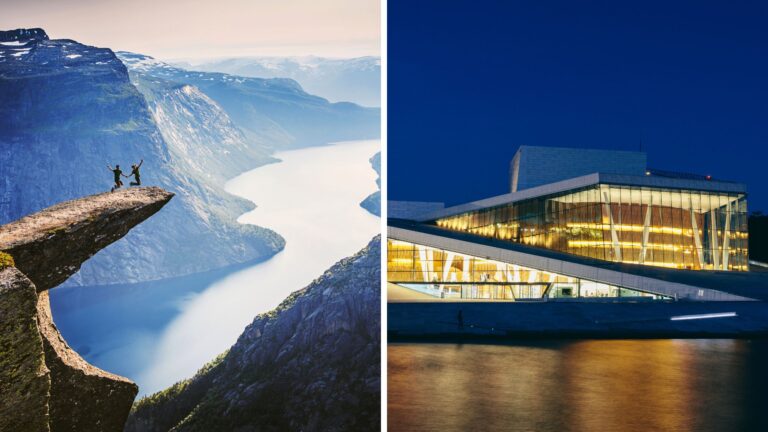
From its mountains and fjords to eye-catching historic and modern architecture, Norway has plenty of instantly recognisable icons throughout the country. Here are our pick of the best natural and man-made landmarks.
Natural landmarks in Norway
Norway's breathtaking nature is a massive tourist draw today just as it was hundreds of years ago when European royalty frequently toured the fjords in the summer.
The Norwegian fjords
Carved by glaciers over vast periods of time, the Norwegian fjords are a true icon of Norway. Even though fjords can be found elsewhere in the world including Alaska, Iceland, Chile and New Zealand, the Norwegian version draws travellers from across the world.
While the west of Norway is marketed as the “fjord Norway” region, fjords can actually be found all over the country. But the western region does contain the most famous as well as the UNESCO World Heritage site protected area.
While they are a must-see sight in Norway, the fjords are far more than just a tourist attraction. They hold important cultural heritage as key factors in the growth of early Scandinavian society, providing food and a vital transport link for trading.

Such is the importance of this landmark, only zero-emission vessels will soon be able to sail along the World Heritage fjords including the Geirangerfjord and Nærøyfjord.
Jotunheimen National Park
The Scandinavian mountains define so much of Norway's natural geography that it's hard not to include them as a landmark. But instead we're including the specific mountains contained with Jotunheimen National Park.
That's because the park contains almost all of Norway's tallest mountains. As one of the best places to experience the outdoors in Norway, the park offers incredible views, challenging hikes and opportunities for wild camping.
The mountain Galdhøpiggen is the bucket list destination for many visitors to the region, and with good reason. It's Norway's tallest mountain. Despite its status, it is nowhere near as difficult to climb as you might expect.
Preikestolen
Fuelled by photos shared on social media and scenes from major motion pictures filmed there, Pulpit Rock is somewhere that has achieved new levels of popularity over the last two decades.

The square clifftop overlooks the Lysefjord to the east of Stavanger, and is one of the most popular day trips from the city. Getting there requires a hike and you'll need a reasonable level of physical fitness.
Trolltunga
Hovering 700 metres above Ringedalsvatnet lake, the famous hike to Trolltunga draws tourists from all over the world. In 2021, Trolltunga was certified as one of Norway’s first national hiking routes.
However, it does require a challenging multi-hour hike to reach, something which trips up many international visitors. So if you do want to reach ‘the troll's tongue', do your research first and book at least one overnight stop in or around Odda.
Kjeragbolten
Another famous hike with a photo opportunity at the end, Kjeragbolten is less-trafficked by tourists because it's a more challenging hike.

You can expect to scramble across wet, slippery, granite rocks using fixed chain ropes for some of the journey.
The end point is the Kjerag boulder, wedged into a crevasse almost 1,000 metres above the Lysefjord. Although it's less popular than some of the other famous hikes, you'll still likely have to queue to get the photo that everyone wants!
The Lofoten wall
Norway's nature is spectacular from north to south, east to west. But with dramatic, imposing beauty everywhere you look, Lofoten stands apart.
The string of granite mountains rise dramatically out of the chilly northern ocean reaching heights well over 1,000 metres. It's a stunning sight, especially when approaching by ship.

When crossing the water from Bodø on the coastal voyage or express ferry, the mountains rise like a wall in front of you, leading to the nickname, Lofoten wall.
The North Cape
Norway's North Cape (Nordkapp) is a north-facing clifftop at the very north of the country. Although it's not technically the northernmost point, the clifftop provides an uninterrupted view north and is a great spot to enjoy the midnight sun.
It really does feel like the edge of the earth. There is a visitor centre at the clifftop together with the famous globe monument for that must-have selfie.
More interesting than Nordkapp itself is the journey there, especially if you are driving. You'll pass changing scenery and remote communities and learn a lot about life in Northern Norway.

There are of course far more natural landmarks in Norway than these. There's the “hole in the mountain” near Brønnøysund, the seven sisters waterfall in the Geirangerfjord, Alta Canyon and many, many more. But let's now move on to the landmarks built by the human hand.
Built landmarks in Oslo
Norway's capital city Oslo is home to several famous buildings and other built landmarks.
Akershus fortress
One of the oldest landmarks in the city, Akershus castle and fortress was built on the waterfront in the late 13th century to protect the city and provide a royal residence. It's since been used as a military base and even a prison.
Today the castle and grounds remain an active military site, but it's primarily known as a recreational area for the people of Oslo and a tourist attraction.
Its status as tourist attraction is boosted by the fantastic views across the waterfront and the two on-site museums.

The Norwegian Resistance Museum tells the story of domestic events during the German occupation of Norway in World War II, while the Armed Forces Museum covers Norwegian military history.
Holmenkollen ski jump & arena
High up on the hill on the western side of Oslo, Holmenkollen ski jump sparkles in the sunshine. Ever since the end of the 1800s, Holmenkollen and its surroundings have drawn large numbers of skiers every winter.
Ski jumping competitions first took place here in 1892. Various jumps and permanent spectator stands were built over the years.
The present eye-catching ski jump was built ahead of the 2011 World Championships and quickly became an icon of Oslo and of Norwegian skiing.
Oslo Opera House
Throughout the year, Oslo Opera House hosts many performances, plays, concerts and other events. But most people visit simply to walk on the famous sloped roof and take in the views of the fjord and city.
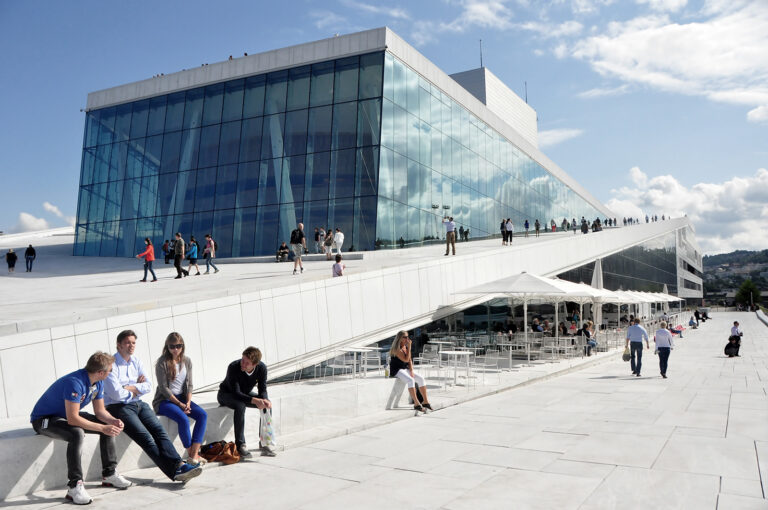
The outdoor spaces are fantastic to explore, and you don't even need miss out on the culture going on inside the building. During the summer, many short outdoor concerts take place.
The daring architecture was controversial at first but has gone on to prove immensely popular. According to Visit Norway, the media attention has helped Oslo attract internationally renowned opera and ballet performances to the city.
Royal Palace
A mighty sight for anyone walking up Karl Johans gate, the Royal Palace is the official residence of the King of Norway. Built in the 19th century, the Palace first served as the residence of French-born King Charles III John, who reigned as king of Norway and Sweden.
Many tourists visit the palace but not all of them take the time to explore the gardens behind. That's a shame, especially since the addition of the fairytale-inspired sculpture park.

Once again, there's plenty more landmarks in and around the capital. But now, it's time to spread our wings and see some of the top built landmarks in the rest of the country.
Other built landmarks in Norway
Built landmarks elsewhere in Norway include historic and modern churches and some impressive roads.
Nidaros cathedral, Trondheim
Let's start with my adopted home town, Trondheim. The city's most famous landmark is also one of the country's best-known. Nidaros Cathedral was built over the burial site of King Olav II, who became the patron saint of Norway.
From a tourist perspective, the cathedral is best known for its magnificent western facade. Fully restored from 1905 to 1983, the wall is covered in sculptures of saints and other intricate carvings such as angels and gargoyles.
The cathedral remains an important site in Norway. It's the destination for pilgrims undertaking hikes along the St. Olav's Ways and it remains the traditional location for the consecration of new monarchs.
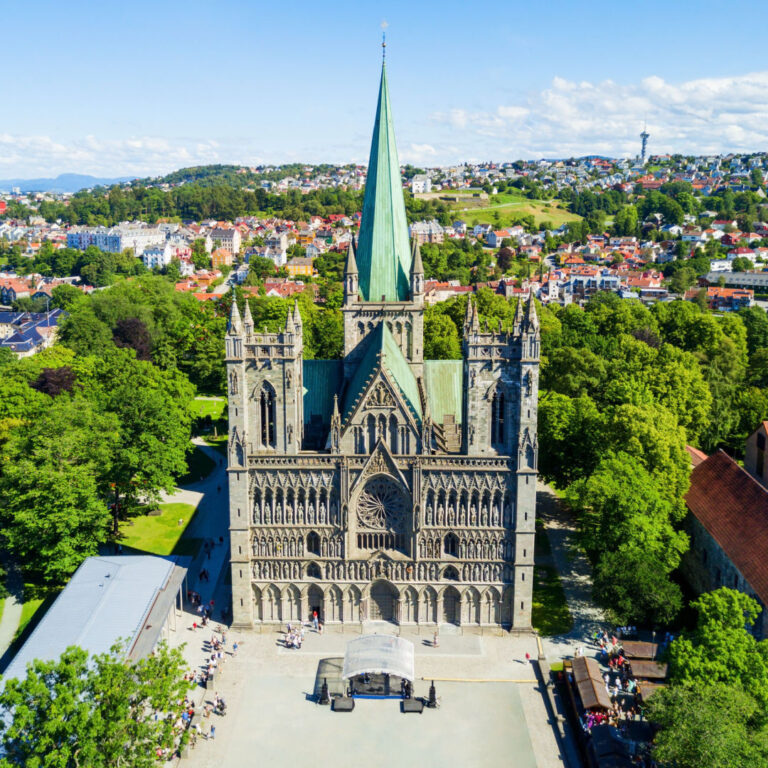
During the summer, the cathedral and the grounds play host to St. Olav's Festival, which attracts people from all across the world. Charter flights are put on from Spain to bring people to the event.
Bryggen, Bergen
Bryggen is Bergen's UNESCO World Heritage site at the very heart of the city. The set of wooden Hanseatic-era warehouses are famous around the world for their colourful facades, but there are so many stories to discover once you've taken your photos.
Don't miss the narrow alleyways that snake between and behind many of the warehouses. Here you'll find boutiques and cafes among the fascinating architecture.
Atlantic Road, Møre og Romsdal
If you never believed a road could look beautiful, think again. The Atlantic Ocean Road has featured in many TV advertisements and films, including the 2021 James Bond movie No Time to Die. As such, it's become one of Norway's most famous road trips.
Linking the western coast of Averøy island with the mainland, the 8.3km stretch of Route 64 dances across skerries and islets interspersed with lookouts, fishing spots, and even the occasional guest accommodation.
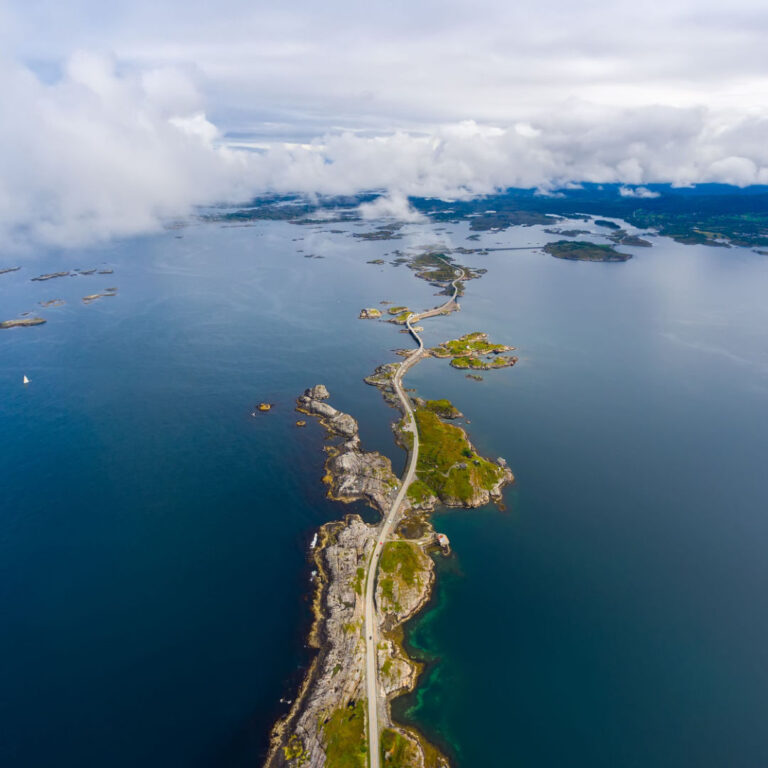
The most famous of the eight bridges is the sweeping Storseisundet, which seems to defy engineering logic from certain angles. In fact, the road was voted as Norway’s greatest engineering feat in 2005.
Arctic cathedral, Tromsø
Tromsø is a popular destination for visitors to northern Norway. Tourists flock to the city in the hope of seeing the northern lights or simply to enjoy life in one of the biggest towns above the Arctic circle.
The church known as the Arctic cathedral has become an iconic symbol of Northern Norway. The striking building is impossible to miss across the water from the city centre.
Thanks to its unique design, it is one of the most famous churches in all of Norway. It's also well known for hosting ‘midnight sun concerts' on many nights during the endless evenings of the summer.
Trollstigen, Møre og Romsdal
Part of route 63, the Troll's Path (Trollstigen) snakes up a mountainside thanks to the 11 hairpin bends. It's one of the most popular Norway road trips and most travellers continue on to Geiranger.
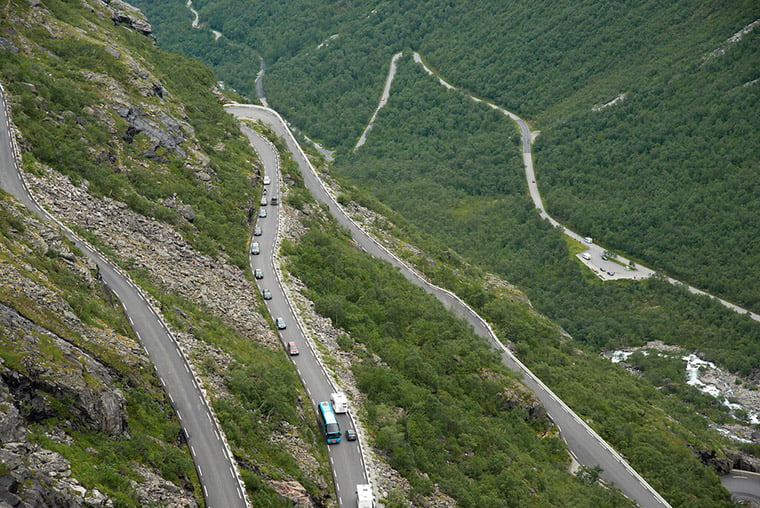
The road is largely single track with many passing points, although these are often clogged with cars pulled over for photographs. Halfway up, an old stone bridge crosses the Stigfossen waterfall, which tumbles over 300 meters.
At the visitor centre at top of the mountain, wooden paths connect you with the rugged mountain landscape. Three viewing platforms allow you to peer down onto the road and valley below.
The largest platform dangles above a sheer drop, but the glass and steel construction keeps you safe as you take in the spectacular view of the racetrack-like road below.
Borgund stave church, Vestland
It's hard to pick just one of Norway's historic stave churches as the majority of them are landmarks for their area. Any one of them would be a worthy addition to your bucket list.
However, I'm going to pick Borgund stave church. The reason? It's well-placed to include on one of many road trip itineraries around the fjord region thanks to its proximity to the Lærdal tunnel, the snow road and the Sognefjord. It's well set up for tourism and visitors in general.

Plus, it's the stave church that my publisher chose to use for the front cover of my Moon Norway guidebook!
Sverd i fjell, Stavanger
This 10-metre-tall monument a short bus ride from central Stavanger consists of three swords planted in the rocky ground of a hill by the Hafrsfjord.
The monument commemorates the Battle of Hafrsfjord, which took place in 872 and is said to have reunited the whole of Norway under the crown of King Harald.
It's not just tourists that flock to the monument. The rocky bay Møllebukta is a popular swimming spot in the summer. A small kiosk serves ice-creams and coffees during the summer.
What are your favourite landmarks in Norway? Do you prefer the natural landmarks or built landmarks? Let us know in the comments below.



2 questions: First, in what format are the photos that you provide for many of the places you mention? In the last 2 years or so, many have changed to color shapeless blobs. Second, why does no one mention the second “tunga”? Have a photo of it, sticking out over a fjord from a forest over a fjord, 500 m vertical. It has been used(so I was told) as a travel company promotional photo. I was told it actually exists and is often seen from a tour boat. IF you tell me how, I would gladly send the photo(will not be a colorless blog !) so you can investigate. Thanks for all you do to promote “Life in Norway”.
My tour of Norway was on a Hurtigruten ship .. I am a seasoned
ex world traveller ( was an officer with P & O !) but approaching 88 possibly for not much longer. Geography (physical) was my favourite subject in student years. If possible can that photo come via internet ?